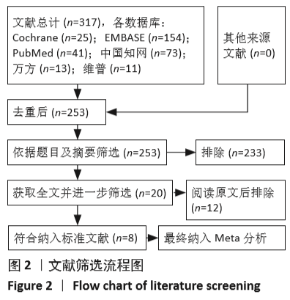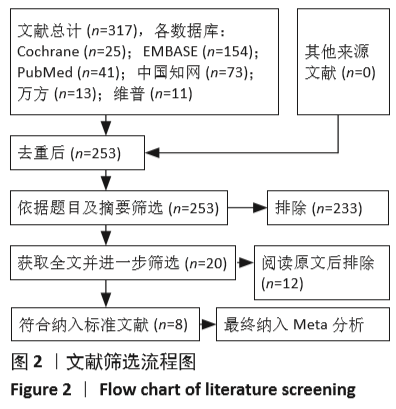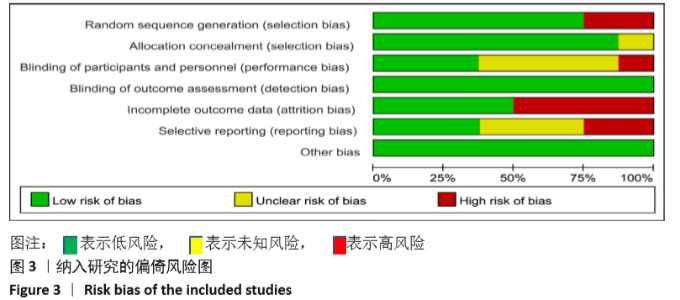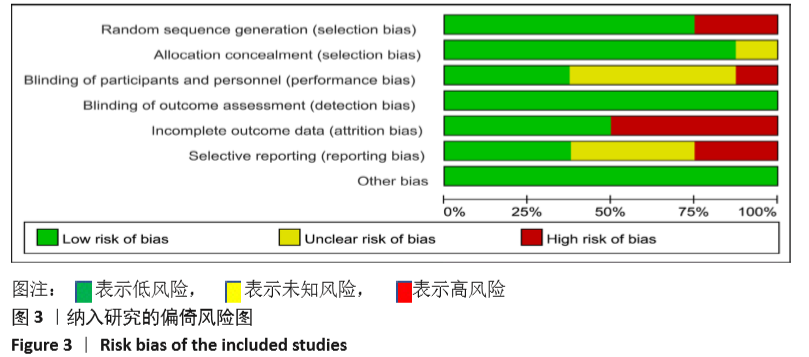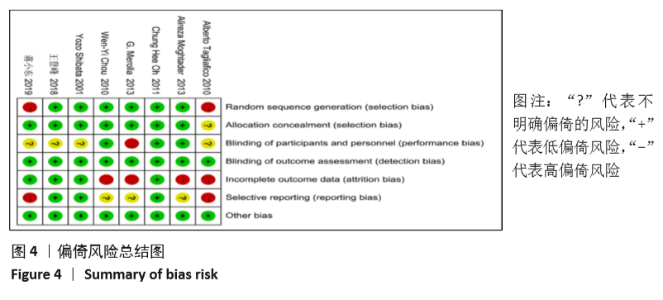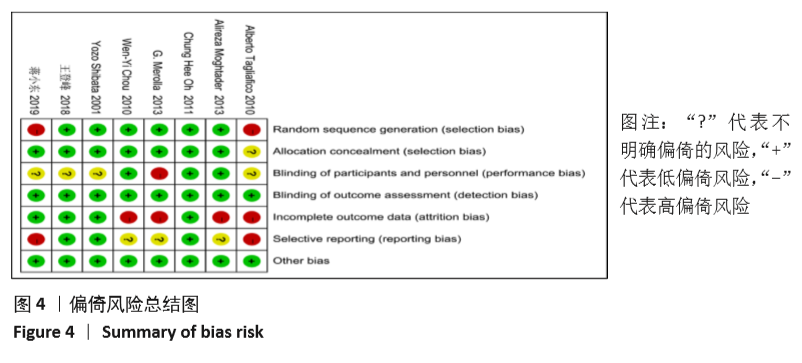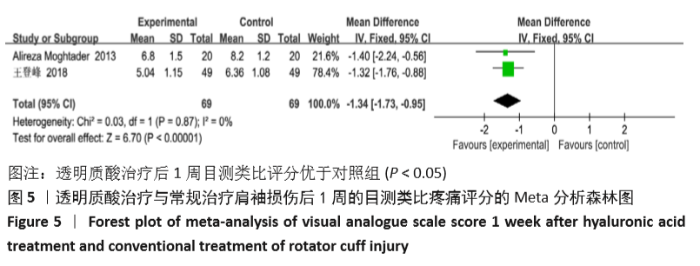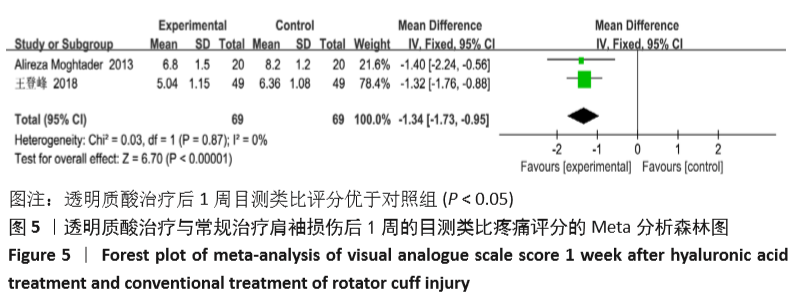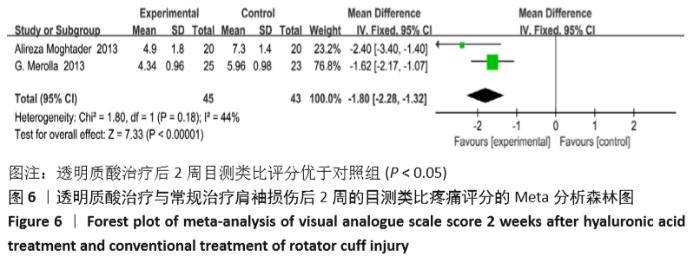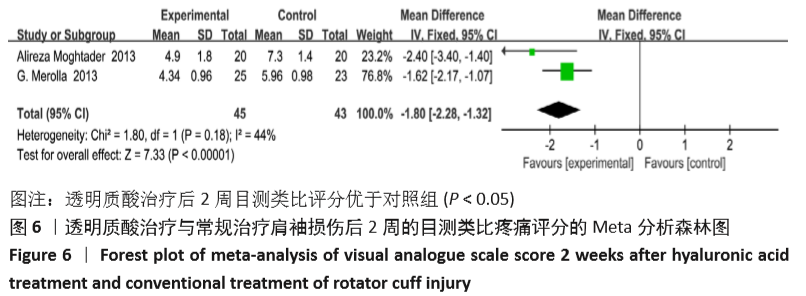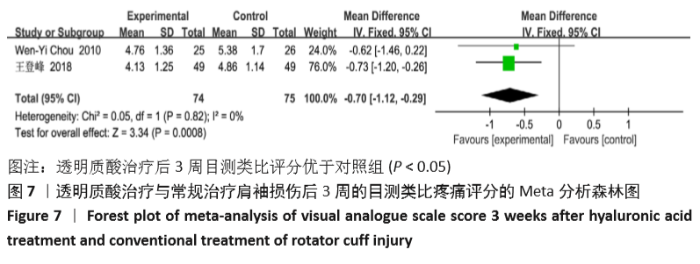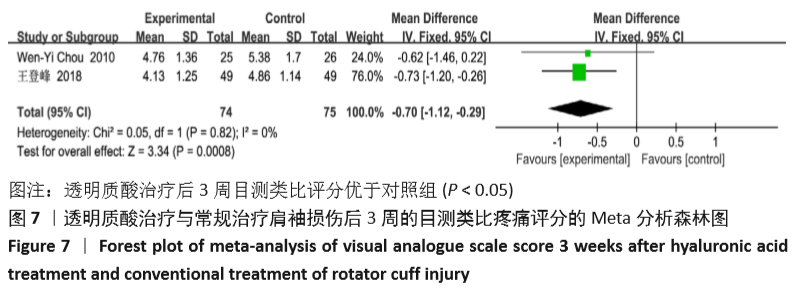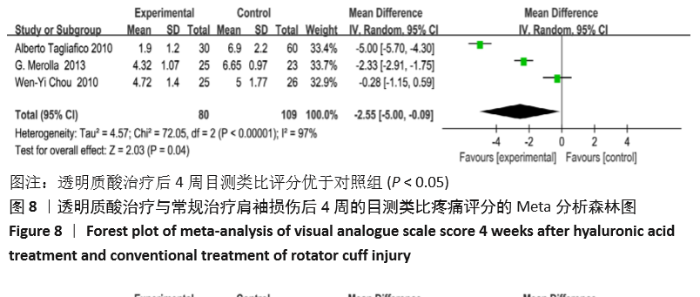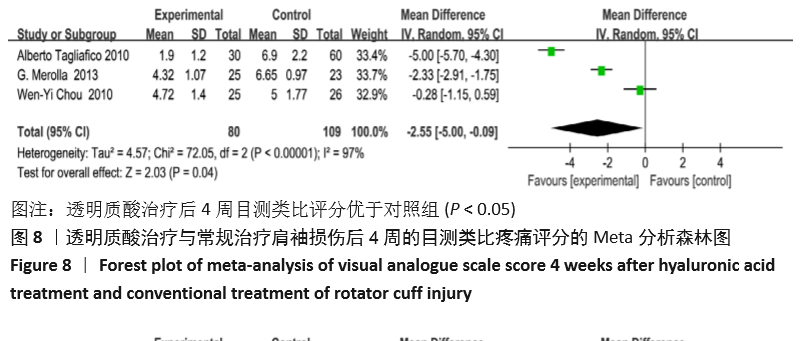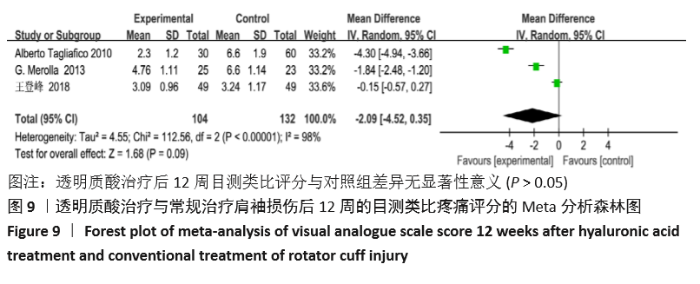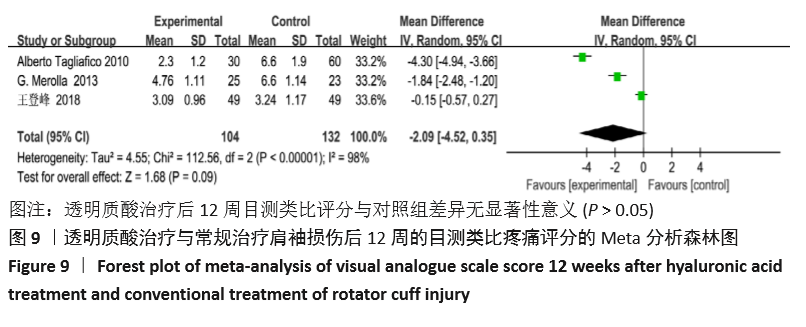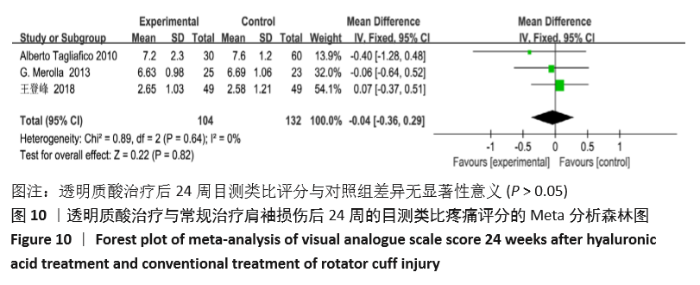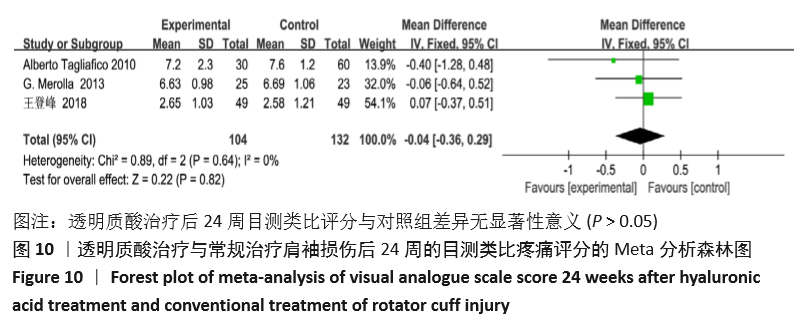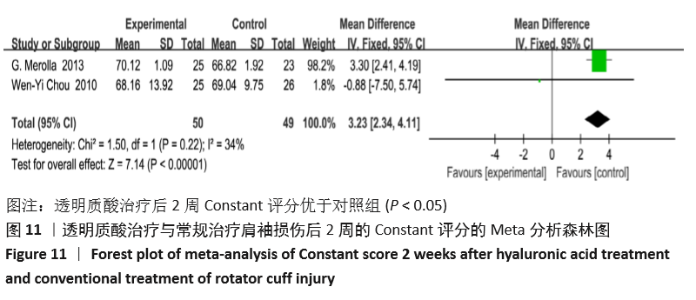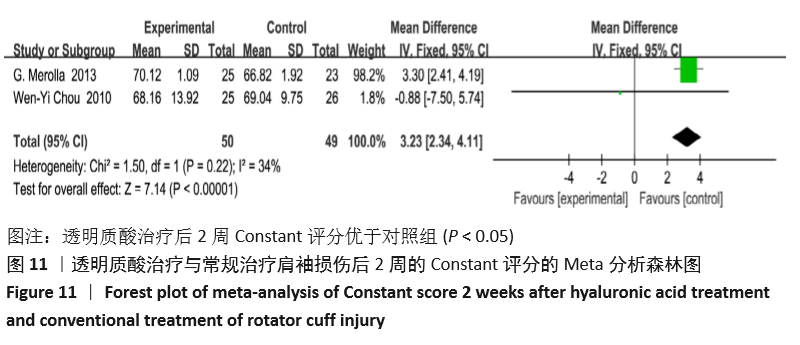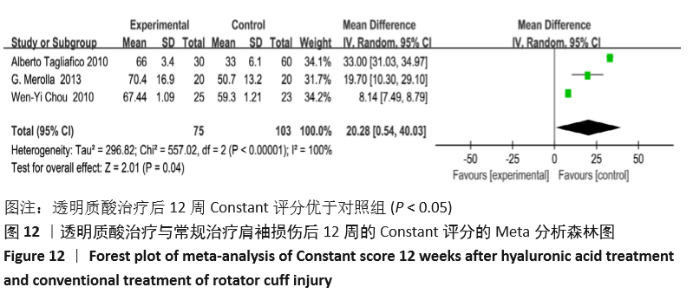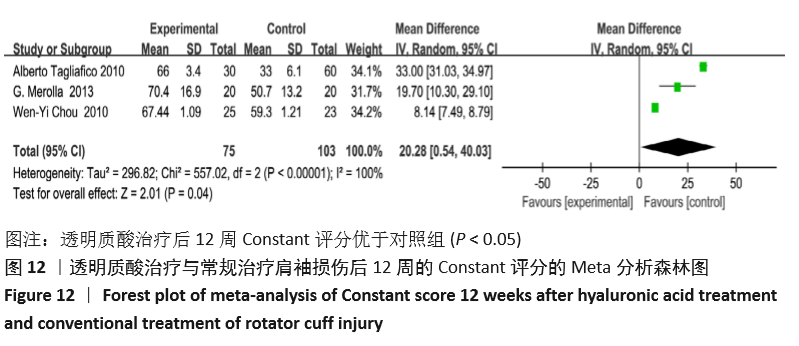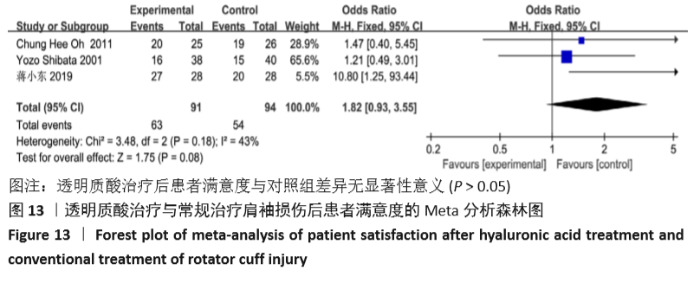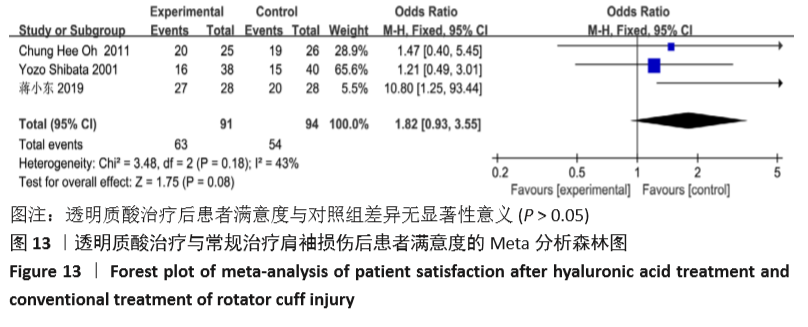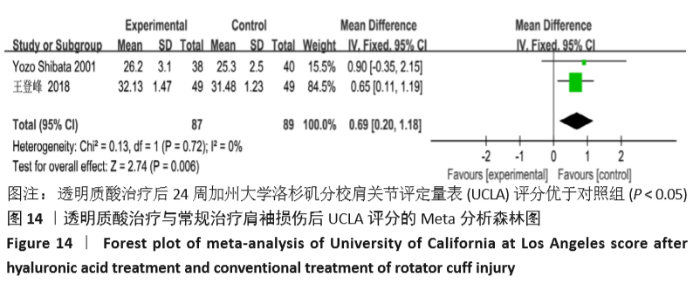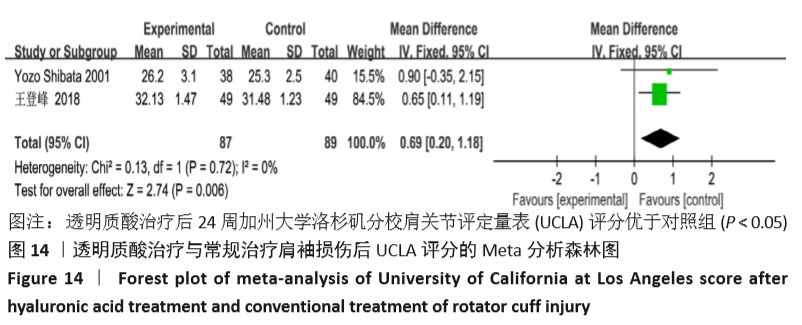Chinese Journal of Tissue Engineering Research ›› 2021, Vol. 25 ›› Issue (28): 4573-4579.doi: 10.12307/2021.075
Previous Articles Next Articles
Meta-analysis of hyaluronic acid in the treatment of rotator cuff injury
Zhao Guoyuan1, Hu Weijian1, Guo Siyin1, Wei Hewei2, Wan Lei2, Zheng Weipeng2, Liu Zhijun2, Liao Zhihao2, Chen Sheng2
- 1The Third Clinical Medical College of Guangzhou University of Chinese Medicine, Guangzhou 510006, Guangdong Province, China; 2Department of Sports Medicine, The Third Affiliated Hospital of Guangzhou University of Chinese Medicine, Guangzhou 510240, Guangdong Province, China
-
Received:2020-06-13Revised:2020-06-17Accepted:2020-07-23Online:2021-10-08Published:2021-05-22 -
Contact:Wei Hewei, MD, Chief physician, Department of Sports Medicine, The Third Affiliated Hospital of Guangzhou University of Chinese Medicine, Guangzhou 510240, Guangdong Province, China -
About author:Zhao Guoyuan, Master candidate, The Third Clinical Medical College of Guangzhou University of Chinese Medicine, Guangzhou 510006, Guangdong Province, China -
Supported by:the Scientific Research Project of Guangdong Provincial Bureau of Traditional Chinese Medicine, No. 20203011 (to WHW)
CLC Number:
Cite this article
Zhao Guoyuan, Hu Weijian, Guo Siyin, Wei Hewei, Wan Lei, Zheng Weipeng, Liu Zhijun, Liao Zhihao, Chen Sheng. Meta-analysis of hyaluronic acid in the treatment of rotator cuff injury[J]. Chinese Journal of Tissue Engineering Research, 2021, 25(28): 4573-4579.
share this article
Add to citation manager EndNote|Reference Manager|ProCite|BibTeX|RefWorks
| [1] PEREIRA H, SOUSA DA, CUNHA A, et al. Hyaluronic Acid. Adv Exp Med Biol. 2018;1059:137-153. [2] BYTOMSKI JR, BLACK D. Conservative treatment of rotator cuff injuries. J Surg Orthop Adv. 2006; 15(3):126-131. [3] YAMAGUCHI K, DITSIOS K, MIDDLETON WD, et al. The demographic and morphological features of rotator cuff disease. A comparison of asymptomatic and symptomatic shoulders. J Bone Joint Surg Am. 2006;88(8):1699-1704. [4] CAI YU, SUN Z, LIAO B, et al. Sodium hyaluronate and platelet-rich plasma for partial-thickness rotator cuff tears. Med Sci Sports Exerc. 2019; 51(2):227-233. [5] 刘岩,余曦,何红晨,等.肩袖损伤修复中的生物治疗[J].中国组织工程研究,2019,23(20): 3248-3254. [6] ANNASWAMY TM, GOSAI EV, JEVSEVAR DS, et al. The Role of Intra-articular Hyaluronic Acid in Symptomatic Osteoarthritis of the Knee. PM R. 2015;7(9):995-1001. [7] MOHER D, LIBERATI A, TETZLAFF J, et al. Preferred reporting items for systematic reviews and meta-analyses: the PRISMA statement. BMJ. 2009;339: b2535. [8] HIGGINS J, GREEN SE. Cochrane Handbook for Systematic Reviews of Interventions Version 5.0.1. 2008. [Cochrane Central Register of Controlled Trials (CENTRAL) ] [9] JADAD AR, MOORE RA, CARROLL D, et al. Assessing the quality of reports of randomized clinical trials: is blinding necessary? Control Clin Trials. 1996;17(1):1-12. [10] MOGHTADERI A, SAJADIYEH S, KHOSRAWI S, et al. Effect of subacromial sodium hyaluronate injection on rotator cuff disease: a double-blind placebo-controlled clinical trial. Adv Biomed Res. 2013;2(1):89. [11] CHOU W, KO J, WANG F, et al. Effect of sodium hyaluronate treatment on rotator cuff lesions without complete tears: a randomized, double-blind, placebo-controlled study. J Shoulder Elbow Surg. 2010;19(4):557-563. [12] MEROLLA G, BIANCHI P, PORCELLINI G. Ultrasound-guided subacromial injections of sodium hyaluronate for the management of rotator cuff tendinopathy: a prospective comparative study with rehabilitation therapy. Musculoskelet Surg. 2013;97 Suppl 1:49-56. [13] OH CH, OH JH, KIM SH, et al. Effectiveness of subacromial anti-adhesive agent injection after arthroscopic rotator cuff repair: prospective randomized comparison study. Clin Orthop Surg. 2011;3(1):55. [14] SHIBATA Y, MIDORIKAWA K, Emoto G, et al. Clinical evaluation of sodium hyaluronate for the treatment of patients with rotator cuff tear. 2001;10(3):209-216. [15] TAGLIAFICO A, SERAFINI G, SCONFIENZA LM, et al. Ultrasound-guided viscosupplementation of subacromial space in elderly patients with cuff tear arthropathy using a high weight hyaluronic acid: prospective open-label non-randomized trial. Eur Radiol. 2011;21(1):182-187. [16] 王登峰,康汇.关节镜下肩袖修补术联合玻璃酸钠局部注射与传统关节镜下肩袖修补术治疗肩袖损伤的随机前瞻性研究[J].美中国际创伤杂志,2018,17(2):1-4,16. [17] 蒋小东.肩峰下注射玻璃酸钠治疗肩袖部分损伤的疗效观察[J].海峡药学,2019,31(3):152-153. [18] MORELAND LW. Intra-articular hyaluronan (hyaluronic acid) and hylans for the treatment of osteoarthritis: mechanisms of action. Arthritis Res Ther. 2003;5(2):54-67. [19] GHOSH P. The role of hyaluronic acid (hyaluronan) in health and disease: interactions with cells, cartilage and components of synovial fluid. Clin Exp Rheumatol. 1994;12(1):75-82. [20] LIM TK, KOH KH, SHON MS, et al. Intra-articular injection of hyaluronate versus corticosteroid in adhesive capsulitis. Orthopedics. 2014;37(10): e860-e865. [21] 张祥,胡柯军,孔祥丽.显微外科技术联合透明质酸钠治疗手指屈伸肌腱损伤68例临床观察[J].安徽医药,2019,23(7):1459-1461. [22] 王伟,韦民,臧危平,等.肩袖损伤模型大鼠肌腱组织中4种生长因子表达及皮质激素和透明质酸的干预[J].中国组织工程研究与临床康复, 2008,12(42):8331-8336. [23] HONDA H, GOTOH M, KANAZAWA T, et al. Hyaluronic acid accelerates tendon-to-bone healing after rotator cuff repair. Am J Sports Med. 2017;45(14):3322-3330. [24] LI H, CHEN Y, CHEN S. Enhancement of rotator cuff tendon-bone healing using bone marrow-stimulating technique along with hyaluronic acid. J Orthop Translat. 2019;17:96-102. [25] OSTI L, BERARDOCCO M, DI GIACOMO V, et al. Hyaluronic acid increases tendon derived cell viability and collagen type I expression in vitro: comparative study of four different Hyaluronic acid preparations by molecular weight. BMC Musculoskelet Disord. 2015;16:284. [26] KOVACEVIC D, RODEO SA. Biological augmentation of rotator cuff tendon repair. Clin Orthop Relat Res. 2008;466(3):622-633. [27] FLORES C, BALIUS R, ALVAREZ G,等.透明质酸治疗冈上肌肌腱炎[J].中国康复,2018,33(1):22. [28] VALENCIA MM, RUIA IM, DIAZ HJ, et al. Stem cell therapy in the management of shoulder rotator cuff disorders. World J Stem Cells. 2015;7(4):691-699. [29] 万富贵,蔡青,吕凌云.手部屈肌肌腱断裂修复术后应用透明质酸钠的效果观察[J].西南国防医药,2019,29(1):47-49. [30] NODA T, OKUDA T, MIZUNO R, et al. Two-step sustained-release plga/hyaluronic acid gel formulation for intra-articular administration. Biol Pharm Bull. 2018;41(6):937-943. [31] BLAINE T, MOSKOWITZ R, Udell J, et al. Treatment of persistent shoulder pain with sodium hyaluronate: a randomized, controlled trial. A multicenter study. J Bone Joint Surg Am. 2008;90(5):970-979. [32] CONSTANT CR, GERBER C, EMERY R J, et al. A review of the Constant score: modifications and guidelines for its use. J Shoulder Elbow Surg. 2008;17(2):355-361. [33] KURTH T, HENNEKENS CH, STURMER T, et al. Analgesic use and risk of subsequent hypertension in apparently healthy men. Arch Intern Med. 2005;165(16):1903-1909. [34] 范智荣,苏海涛,江涛,等.肩关节镜术后关节腔内注射皮质类固醇激素安全性的系统评价与Meta分析[J].中国组织工程研究,2020, 24(24):3931-3936. [35] CUMMINS CA, SASSO LM, NICHOLSON D. Impingement syndrome: temporal outcomes of nonoperative treatment. J Shoulder Elbow Surg. 2009;18(2):172-177. [36] MEYER K, THOMPSON R, PALMER JW, et al. The nature of lysozyme action. Science. 1934; 79(2038):61. [37] PEYRON JG, BALAZS EA. Preliminary clinical assessment of Na-hyaluronate injection into human arthritic joints. Pathol Biol (Paris). 1974; 22(8):731-736. |
| [1] | Li Dadi, Zhu Liang, Zheng Li, Zhao Fengchao. Correlation of total knee arthroplasty efficacy with satisfaction and personality characteristics [J]. Chinese Journal of Tissue Engineering Research, 2021, 25(9): 1346-1350. |
| [2] | Wei Wei, Li Jian, Huang Linhai, Lan Mindong, Lu Xianwei, Huang Shaodong. Factors affecting fall fear in the first movement of elderly patients after total knee or hip arthroplasty [J]. Chinese Journal of Tissue Engineering Research, 2021, 25(9): 1351-1355. |
| [3] | Wang Haiying, Lü Bing, Li Hui, Wang Shunyi. Posterior lumbar interbody fusion for degenerative lumbar spondylolisthesis: prediction of functional prognosis of patients based on spinopelvic parameters [J]. Chinese Journal of Tissue Engineering Research, 2021, 25(9): 1393-1397. |
| [4] | Lü Zhen, Bai Jinzhu. A prospective study on the application of staged lumbar motion chain rehabilitation based on McKenzie’s technique after lumbar percutaneous transforaminal endoscopic discectomy [J]. Chinese Journal of Tissue Engineering Research, 2021, 25(9): 1398-1403. |
| [5] | Chen Junming, Yue Chen, He Peilin, Zhang Juntao, Sun Moyuan, Liu Youwen. Hip arthroplasty versus proximal femoral nail antirotation for intertrochanteric fractures in older adults: a meta-analysis [J]. Chinese Journal of Tissue Engineering Research, 2021, 25(9): 1452-1457. |
| [6] | Chen Jinping, Li Kui, Chen Qian, Guo Haoran, Zhang Yingbo, Wei Peng. Meta-analysis of the efficacy and safety of tranexamic acid in open spinal surgery [J]. Chinese Journal of Tissue Engineering Research, 2021, 25(9): 1458-1464. |
| [7] | Hu Kai, Qiao Xiaohong, Zhang Yonghong, Wang Dong, Qin Sihe. Treatment of displaced intra-articular calcaneal fractures with cannulated screws and plates: a meta-analysis of 15 randomized controlled trials [J]. Chinese Journal of Tissue Engineering Research, 2021, 25(9): 1465-1470. |
| [8] | Huang Dengcheng, Wang Zhike, Cao Xuewei. Comparison of the short-term efficacy of extracorporeal shock wave therapy for middle-aged and elderly knee osteoarthritis: a meta-analysis [J]. Chinese Journal of Tissue Engineering Research, 2021, 25(9): 1471-1476. |
| [9] | Wang Yongsheng, Wu Yang, Li Yanchun. Effect of acute high-intensity exercise on appetite hormones in adults: a meta-analysis [J]. Chinese Journal of Tissue Engineering Research, 2021, 25(8): 1305-1312. |
| [10] | Gao Yan, Zhao Licong, Zhao Hongzeng, Zhu Yuanyuan, Li Jie, Sang Deen. Alteration of low frequency fluctuation amplitude at brain-resting state in patients with chronic discogenic low back pain [J]. Chinese Journal of Tissue Engineering Research, 2021, 25(8): 1160-1165. |
| [11] | Shen Jinbo, Zhang Lin. Micro-injury of the Achilles tendon caused by acute exhaustive exercise in rats: ultrastructural changes and mechanism [J]. Chinese Journal of Tissue Engineering Research, 2021, 25(8): 1190-1195. |
| [12] | Wang Xianyao, Guan Yalin, Liu Zhongshan. Strategies for improving the therapeutic efficacy of mesenchymal stem cells in the treatment of nonhealing wounds [J]. Chinese Journal of Tissue Engineering Research, 2021, 25(7): 1081-1087. |
| [13] | Kong Desheng, He Jingjing, Feng Baofeng, Guo Ruiyun, Asiamah Ernest Amponsah, Lü Fei, Zhang Shuhan, Zhang Xiaolin, Ma Jun, Cui Huixian. Efficacy of mesenchymal stem cells in the spinal cord injury of large animal models: a meta-analysis [J]. Chinese Journal of Tissue Engineering Research, 2021, 25(7): 1142-1148. |
| [14] | Zhao Zhongyi, Li Yongzhen, Chen Feng, Ji Aiyu. Comparison of total knee arthroplasty and unicompartmental knee arthroplasty in treatment of traumatic osteoarthritis [J]. Chinese Journal of Tissue Engineering Research, 2021, 25(6): 854-859. |
| [15] | Zhang Nianjun, Chen Ru. Analgesic effect of cocktail therapy combined with femoral nerve block on total knee arthroplasty [J]. Chinese Journal of Tissue Engineering Research, 2021, 25(6): 866-872. |
| Viewed | ||||||
|
Full text |
|
|||||
|
Abstract |
|
|||||
